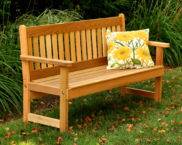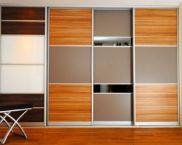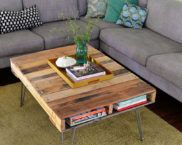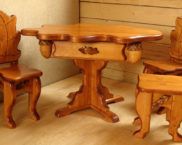Wood stain: varieties, characteristics, application features
Wood is a very popular building and decoration material. However, its resistance to external factors, especially humidity, leaves much to be desired. Many technologies have been developed to protect wood products. Wood stain is one of the first ways to protect such products. It continues to be the most effective of the existing ones. In this article we will talk about the performance characteristics, advantages, disadvantages and decorative properties of various types of wood stain. Let's explain how to make it with your own hands. We will give the application technology and the rules for correcting defects.
The content of the article [Hide]
- 1 Appointment of stain and its difference from paintwork materials
- 2 Wood stain - classification by composition
- 3 Consumption
- 4 Color palette
- 5 Video: comparison of shades of stains from different manufacturers
- 6 Manufacturers
- 7 Selection features
- 8 Application technology
- 9 Correction of possible errors
- 10 Do-it-yourself stain
- 11 Outcome
Appointment of stain and its difference from paintwork materials
The main purpose of the stain is to protect wood from external natural and man-made factors. While retaining its natural texture, it can give the wood surface almost any color shade.
The main difference from paints and varnishes is increased light transmittance, as well as enhanced moisture resistance. Stains penetrate deeper into the surface of the wood, forming a protective layer that protects the material from decay, wood-boring insects, moisture deformation.
Wood stain - classification by composition
Depending on the composition, the performance and application technology of the stain can vary significantly.
Water
The most common and affordable type of stain. Has a wide range of colors. It is produced both in the form of ready-made compositions and in the form of a water-soluble powder. In the second case, the intensity of the color depends on the amount of powder added to the water when preparing the composition.
Benefits: no pungent odor and toxic emissions, recommended for indoor use.
disadvantages: When applied, slightly lifts wood grain, which increases the material's susceptibility to moisture. Long time of complete drying, which is about 12-14 hours.
Alcohol and nitromorilac
It is an alcoholic solution of aniline dyes. Denatured alcohol is used as a solvent. Also produced as a ready-made solution or powder. A distinctive feature is the high speed of drying - 20-30 minutes, which is both an advantage and a disadvantage.
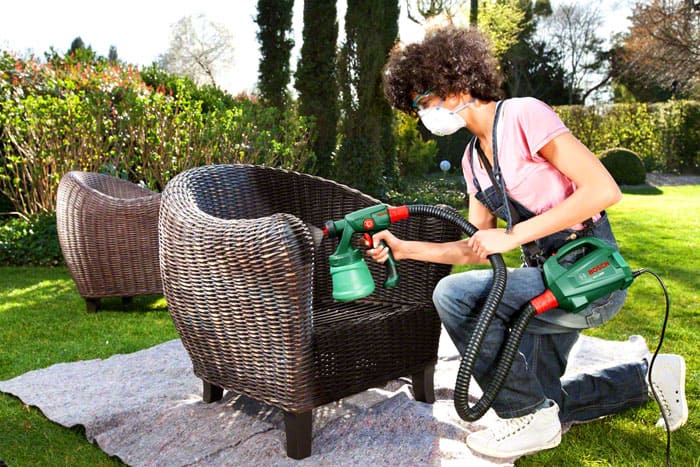
For the application of nitromorilac from alcohol-based formulations, it is recommended to use spray guns
High humidity and inaccurate brushing during application can lead to uneven pigmentation of the treated surface. Therefore, in order to obtain a uniform color, it is strongly recommended to use vacuum or pneumatic spray guns.
Advantages: fast drying, affordable cost;
disadvantages: high probability of staining with manual application, strong and unpleasant odor, toxic emissions (especially nitromorilac).
Oil
It is one of the most convenient for manual application. Dissolving the different segments in oil gives a wide range of colors and a fade-resistant shade. White spirit is used as a solvent, the base is industrial linseed oil.
Benefits: does not form stains, does not raise fibers, provides a high degree of protection of wood from external factors, dries up in 2-3 hours;
disadvantages: an unpleasant odor that disappears after a rather long time after application: from several days to several weeks.
Acrylic
It is produced in the form of aqueous dispersions of acrylic polymers with the addition of pigments. Such formulations have practically no drawbacks, except for the high cost.
Advantages: dries up in 2-3 hours, has no odor, does not emit corrosive or toxic fumes during application and during further operation, forms a uniform coating without stains, provides reliable protection of wood.
disadvantages: high price.
Wax
The composition is represented by an aqueous suspension of wax. It has a high density, it is applied with a cloth. Does not absorb into the material. Forms a relatively thick protective layer on the wood surface. It is used as a base "primer" for various paints and varnishes and for polishing the product with beeswax.
Advantages: Uniform pigmentation, reliable protection of base, does not reduce moisture absorption.
disadvantages: high cost, laboriousness of application.
Consumption
The stain absorbs well into the wood. In addition, when buying the required amount of finishing material, it is necessary to take into account the porosity of the base. As a rule, 1 liter of ready-to-use mortar is sufficient for processing 12-15 m². However, the method of application and the type of building structures should be considered. For example, when applying stain from a spray gun, nozzle diameter and pressure are of great importance. The best option for aqueous solutions is 1.5 mm at a pressure of 3 atm, and for alcohol and nitromillocks - 1.3 mm at a pressure of 2-2.5 atm.The stain should only wet the surface to be treated, and not stand there in puddles.
Color palette
The stain is absorbed into the outer layer of the wood surface. It colors the material unevenly, depending on the density of the fibers. Thanks to this, the natural texture of the wood is completely preserved. If earlier with the help of wood stain a tree could only be darkened, now various compositions allow not only to lighten the wood, but also to convey to it various, including saturated, shades. Color saturation depends on the following factors:
The same composition can color different types of wood in different ways. For example, after processing with nitro-stain, oak will acquire a dark brown color, and maple will acquire a yellowish color. It should be borne in mind that conifers absorb stains worse and unevenly. Therefore, before processing, it is necessary to carefully remove the resin from the surface and cover the product in two layers.
Video: comparison of shades of stains from different manufacturers

Manufacturers
Stains are produced by the same companies that produce paints and varnishes. Of the most famous manufacturers, whose products are deservedly popular, the following can be distinguished:
Reviews
Selection features
First of all, it is necessary to select the composition of the stain based on the area of use. They, like other paints and varnishes, are divided into two main groups: internal and external.
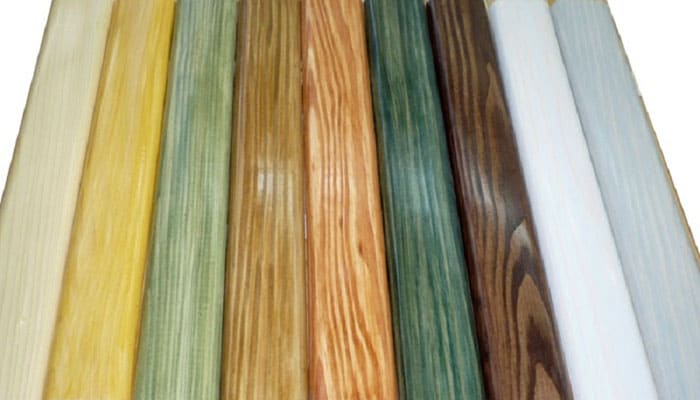
Manufacturers provide a wide choice of wood stains with various performance characteristics and color solutions
Each type of wood has a different structure, the possibility of its coloring depends on it. You should not try to paint coniferous wood in an intense color with the help of stain. You can get spots of different pigmentation on the surface. It is advisable to slightly tint conifers. In contrast, deciduous woods absorb moisture well. Therefore, a wide variety of coloring compositions can be used.
Video: Rules for choosing a stain for interior work

Application technology
There are four main methods of staining.
Grinding - recommended when processing porous wood species. Significantly reduces consumption, allows you to achieve uniform pigmentation, shows wood texture well. The stain is applied to the surface of the base and spread over the entire area using cloth swabs. Recommended for oil and wax compositions.
Roller application - medium density foam roller without relief is used. Prevents the formation of streaks and allows the composition to be more evenly distributed over the entire surface. Recommended for oil stains.
Spraying - both vacuum and pneumatic spray guns and spray guns can be used. The flow rate depends on the working pressure and the nozzle diameter. Recommended for alcohol and nitromorilacs.
Processing with a paint brush - allows you to get a rich color. As a rule, it is produced in two to three layers. Suitable for acrylic and water stains.
Stages of the staining process:
- Carefully prepare the base surface: remove old paintwork, dust and dirt. It is advisable to degrease the surface. When processing conifers, it is imperative to remove the resin using a weak solution of white spirit.
- The first coat should be applied exclusively in the direction of the wood grain.
- If the base is treated with several layers of stain, then each subsequent layer is applied crosswise to the previous one.
- For the first layer, you can use a diluted stain (no more than 10-15% of the total volume).
- After the first layer is dry, it is recommended to sand it to eliminate the raised lint and increase the adhesion between the layers. To do this, use abrasive paper from 180 to 400.
Correction of possible errors
Unlike paint, defects formed as a result of wood staining are extremely difficult to remove. Therefore, when applying, it is necessary to carefully observe the technology for performing work and be extremely careful:
Video: fixing stain defects

Do-it-yourself stain
You can give the wood a different shade and at the same time protect it from external influences with the help of "folk" means.
Herbal ingredients
"Household" materials and substances
To create a stain, you can use materials and substances that are quite common in everyday life:
Chemical stains
- After processing with slaked lime, oak becomes brown, walnut - brownish-olive.
- Any wood veneer can be made olive green by treating it with hot copper powder in vinegar. Take 50-60 g of powder per 0.5 l of 9% table vinegar, boil for 10 minutes, process the wood with a hot solution.
Outcome
Undoubtedly, using home remedies for tinting wood is much more affordable financially.However, from the point of view of protecting wooden structures from external influences, preference should be given to special prefabricated compositions.



























